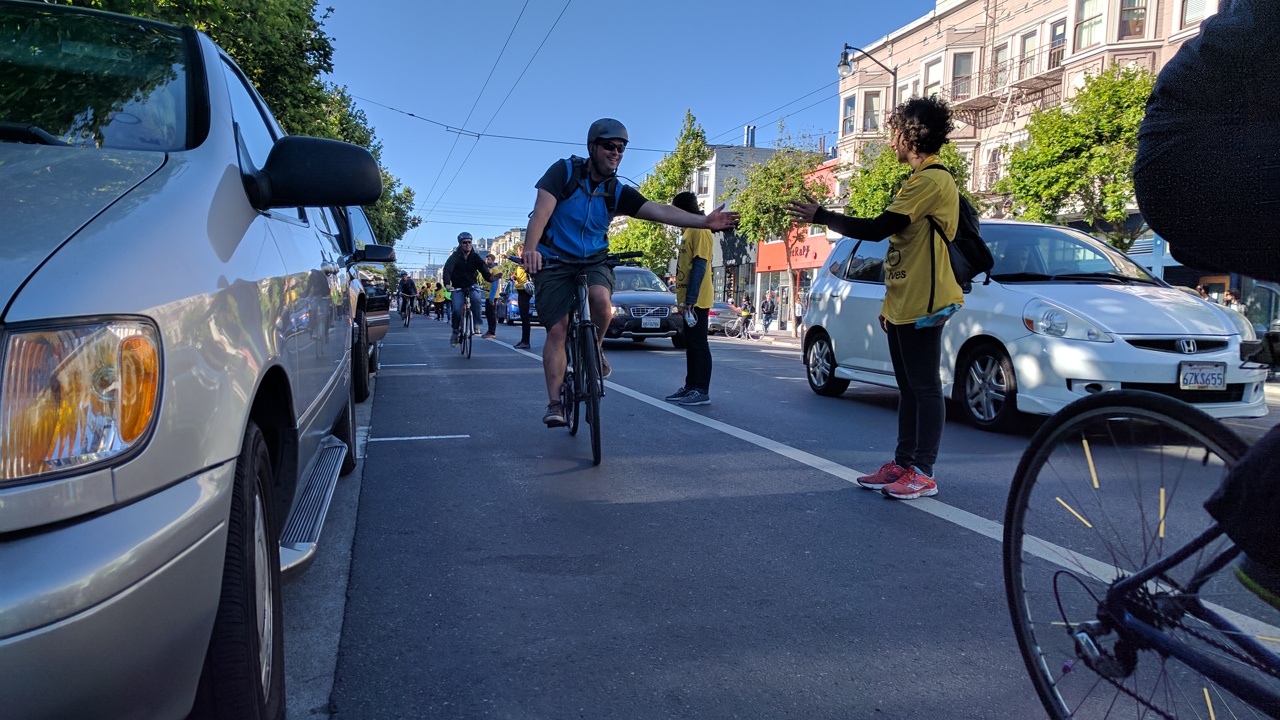Protests, meetings, letters, emails, phone calls, organized bike rides with local politicians--the push by advocates to get safer infrastructure on Valencia may finally be paying off. Mayor London Breed issued an order to the SFMTA this week to hurry up and implement protected bike lanes.
From the mayor's statement:
Mayor Breed will be closely analyzing all pending Vision Zero street safety projects planned for high-injury corridors and directing the San Francisco Municipal Transportation Agency (SFMTA) to implement these projects on an expedited schedule, beginning with the Valencia Street bike lane.
The mayor wants fully parking-protected bike lanes on Valencia Street stretching from Market to 15th implemented in the next four months "to serve as a pilot to inform changes through the rest of the corridor."
“I want to thank Mayor Breed for her leadership in expediting the protected bike lane on Valencia Street, which is one of the most biked and most dangerous corridors in San Francisco,” said Brian Wiedenmeier, Executive Director of the San Francisco Bicycle Coalition, in the statement from the mayor's office. “This kind of quick action is exactly what we need in order to achieve Vision Zero by 2024 and help more people choose to bike in the City.”
The SFBC also had this to say on Twitter:
Thank you @LondonBreed for fast-tracking badly needed safety improvements on Valencia and other high injury corridors. Looking forward to having protected bike lanes! https://t.co/p8dL9iFsqH
— SF Bicycle Coalition (@sfbike) September 26, 2018
As previously reported, the SFMTA had already begun a planning process and had done some incremental improvements on Valencia, including piloting a parking-protected bike lane south of Cesar Chavez last year. The agency has also added safe hit posts in areas adjacent to a few parklets. But it hasn't been nearly enough. Just last August, Bill Couch was struck by a hit-and-run driver on Valencia; he fractured seven vertebrae, broke two ribs and his left thumb, and had a severe concussion.
Valencia Street is one of San Francisco's high-injury corridors, which together represent just 13 percent of San Francisco streets but 75 percent of all serious injuries and fatalities. Although advocates want the protected bike lanes, they are also pushing for a long-term, more radical re-design of Valencia, perhaps turning it into a pedestrianized street with bike lanes and space for delivery trucks, but no through car and truck traffic would be permitted.
"Protected cycle lanes on the first four blocks are an excellent start, but just the start, of its necessary transformation," wrote Tom Radulovich, Executive Director of Livable City, in an email to Streetsblog.
That said, some advocates remain skeptical of the city's ability to deliver safe bike lanes on Valencia and elsewhere. "I sincerely hope that we are not witnessing grandstanding and that Mayor Breed and Director Reiskin remain steadfast in their commitment to urgent action to protect the lives of cyclists on Valencia and throughout our city," wrote Catherine Orland, District 9 representative to the Bicycle Advisory Committee and longtime member and volunteer with the San Francisco Bicycle Coalition. Orland, who did early data collection on Uber and Lyft incursions into the Valencia Street bike lanes, plans to hold the mayor to her order. "If they break their promises after the election [on Nov. 6] I am quite certain that the community will remember and react."
"I don't celebrate announcements. I celebrate construction," added Matt Brezina, the advocate who helped organize the people-protected bike lane protests.
The mayor is also increasing the pressure on the city's Rapid Response team, tasked with making improvements at any location where there is a serious or fatal collision. It will continue to "respond within 24 hours to analyze the location for any necessary safety improvements, and then implement appropriate near-term safety improvements within the following 72 hours" she wrote in her order.
San Francisco has been backsliding on attempts to make its streets safer, with two fatal collisions on Howard Street in SoMa in just the past few weeks, in addition to recent fatal collisions involving a pedestrian in Bernal Heights and a cyclist in the Tenderloin. As of August of this year, there were fourteen people killed in collisions in San Francisco, compared to twelve at the same time in 2017.





